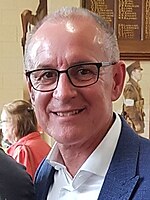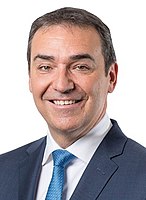
The House of Assembly, or lower house, is one of the two chambers of the Parliament of South Australia. The other is the Legislative Council. It sits in Parliament House in the state capital, Adelaide.
The state election for the 51st Parliament of South Australia was held in the Australian state of South Australia on 18 March 2006 to elect all members of the South Australian House of Assembly and 11 members of the South Australian Legislative Council. The election was conducted by the independent State Electoral Office.

Adelaide is a single-member electoral district for the South Australian House of Assembly. The 22.8 km² state seat of Adelaide currently consists of the Adelaide city centre including North Adelaide and suburbs to the inner north and inner north east: Collinswood, Fitzroy, Gilberton, Medindie, Medindie Gardens, Ovingham, Thorngate, Walkerville, most of Prospect, and part of Nailsworth. The federal division of Adelaide covers the state seat of Adelaide and additional suburbs in each direction.
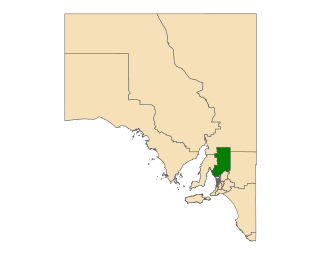
Frome is a single-member electoral district for the South Australian House of Assembly. It is named after Edward Charles Frome, the third surveyor-general of South Australia. The electorate stretches north-eastwards from the Gawler River and Gulf St Vincent in the south, and includes many of the agricultural areas of the Clare and Gilbert Valleys. It covers a total of 12,921 km2 (4,989 sq mi) and takes in the towns of Auburn, Clare, Mintaro, Port Broughton, Saddleworth, Snowtown and Riverton. Prior to the 2020 redistribution, its main population centre was Port Pirie, since transferred to the Stuart.

Fisher was an electoral district of the House of Assembly in the Australian state of South Australia. It was created in 1970 and named after Sir James Fisher, a colonial politician and the first mayor of Adelaide. It was abolished in a 2016 redistribution and its last MP, Nat Cook was elected to represent its replacement, Hurtle Vale, at the 2018 state election. It covers a 94.2 km2 suburban and semi rural area on the southern fringes of Adelaide, taking in the suburbs of Aberfoyle Park, Chandlers Hill, Cherry Gardens, Coromandel East, Happy Valley, Reynella East and parts of Clarendon, O'Halloran Hill and Woodcroft.
The term swing refers to the extent of change in voter support, typically from one election or opinion poll to another, expressed as a positive or negative percentage point. For the Australian House of Representatives and the lower houses of the parliaments of all the states and territories except Tasmania and the ACT, Australia employs preferential voting in single-member constituencies. Under the full-preference instant-runoff voting system, in each seat the candidate with the lowest vote is eliminated and their preferences are distributed, which is repeated until only two candidates remain. While every seat has a two-candidate preferred (TCP) result, seats where the major parties have come first and second are commonly referred to as having a two-party-preferred (TPP) result. The concept of "swing" in Australian elections is not simply a function of the difference between the votes of the two leading candidates, as it is in Britain. To know the majority of any seat, and therefore the swing necessary for it to change hands, it is necessary to know the preferences of all the voters, regardless of their first preference votes. It is not uncommon in Australia for candidates who have comfortable leads on the first count to fail to win the seat, because "preference flows" go against them.

Unley is a single-member electoral district for the South Australian House of Assembly. Named after the suburb of the same name, it is the state's smallest electorate by area at just 14.1 km2 (5.4 sq mi). It is a suburban electorate in Adelaide's inner south, taking in the suburbs of Eastwood, Frewville, Fullarton, Glenside, Glenunga, Goodwood, Highgate, Hyde Park, Kings Park, Malvern, Myrtle Bank, Parkside, Unley, Unley Park and Wayville, as well as parts of Glen Osmond and Millswood.

Robert Bruce Such was a South Australian politician. He was the member for the seat of Fisher in the South Australian House of Assembly from 1989 until his death in 2014. He defeated Labor MP Philip Tyler at the 1989 election and was a member of the Liberals until 2000 when he became an independent. Such was Minister for Employment, Training and Further Education, and Minister for Youth Affairs, in the Brown Liberal government from 1993 to 1996. He served as Speaker of the South Australian House of Assembly for the Rann Labor government from 2005 to 2006. Such was joint Father of the House with Michael Atkinson from 2012.
The Playmander was a gerrymandering system, a pro-rural electoral malapportionment in the Australian state of South Australia, which was introduced by the incumbent Liberal and Country League (LCL) government in 1936, and remained in place for 32 years until 1968.

In Australian politics, the two-party-preferred vote is the result of an election or opinion poll after preferences have been distributed to the highest two candidates, who in some cases can be independents. For the purposes of TPP, the Liberal/National Coalition is usually considered a single party, with Labor being the other major party. Typically the TPP is expressed as the percentages of votes attracted by each of the two major parties, e.g. "Coalition 50%, Labor 50%", where the values include both primary votes and preferences. The TPP is an indicator of how much swing has been attained/is required to change the result, taking into consideration preferences, which may have a significant effect on the result.

The 2010 South Australian state election elected members to the 52nd Parliament of South Australia on 20 March 2010. All seats in the House of Assembly or lower house, whose current members were elected at the 2006 election, and half the seats in the Legislative Council or upper house, last filled at the 2002 election, became vacant.

A by-election was held for the South Australian House of Assembly seat of Frome on 17 January 2009. This was triggered by the resignation of former Premier and state Liberal MHA Rob Kerin. The seat had been retained by the Liberals at the 2006 state election on a 3.4 per cent margin, and at the 2002 state election on an 11.5 per cent margin.

Geoffrey Graeme Brock is an Australian politician. He is an Independent member in the South Australian House of Assembly, representing the seat of Stuart since the 2022 South Australian state election. Prior to this, he represented the seat of Frome from the 2009 Frome by-election until a redistribution leading up to the 2022 state election.

Steven Spence Marshall is an Australian politician who served as the 46th premier of South Australia between 2018 and 2022. He has been a member of the South Australian Division of the Liberal Party of Australia in the South Australian House of Assembly since 2010, representing the electorate of Dunstan.

A by-election occurred in the South Australian House of Assembly seat of Port Adelaide on 11 February 2012. Labor's Susan Close won the seat on a 52.9 percent two-candidate-preferred (TCP) vote. The by-election was triggered by the resignation of former Deputy Premier, Treasurer and state Labor MHA Kevin Foley.

A by-election occurred in the South Australian House of Assembly seat of Ramsay on 11 February 2012. The seat was won by Labor candidate Zoe Bettison. The by-election was triggered by the resignation of former Premier and state Labor MHA Mike Rann.

The 2018 South Australian state election to elect members to the 54th Parliament of South Australia was held on 17 March 2018. All 47 seats in the House of Assembly or lower house, whose members were elected at the 2014 election, and 11 of 22 seats in the Legislative Council or upper house, last filled at the 2010 election, were contested. The record-16-year-incumbent Australian Labor Party (SA) government led by Premier Jay Weatherill was seeking a fifth four-year term, but was defeated by the opposition Liberal Party of Australia (SA), led by Opposition Leader Steven Marshall. Nick Xenophon's new SA Best party unsuccessfully sought to obtain the balance of power.

A by-election for the seat of Fisher in the South Australian House of Assembly was held on 6 December 2014. The by-election was triggered by the death of independent MP Bob Such on 11 October 2014. Originally elected to Fisher for the Liberal Party of Australia at the 1989 election, defeating the one-term Australian Labor Party MP Philip Tyler, Such left the party in 2000.
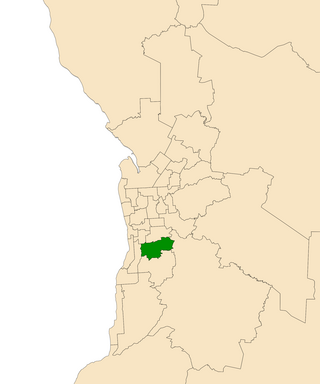
A by-election for the seat of Davenport in the South Australian House of Assembly was held on 31 January 2015. The by-election was triggered by the resignation of Liberal Party of Australia MP and former Liberal leader Iain Evans, who retained the seat at the 2014 election on a 58.1 (−2.8) percent two-party-preferred vote. Liberal Sam Duluk went on to win the seat despite a five-point two-party swing, turning the historically safe seat of Davenport in to a marginal for the first time.
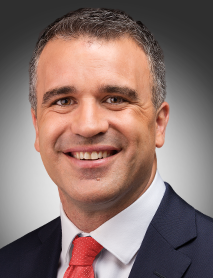
The 2022 South Australian state election was held on 19 March 2022 to elect members to the 55th Parliament of South Australia. All 47 seats in the House of Assembly, and half the seats in the Legislative Council were up for re-election.

